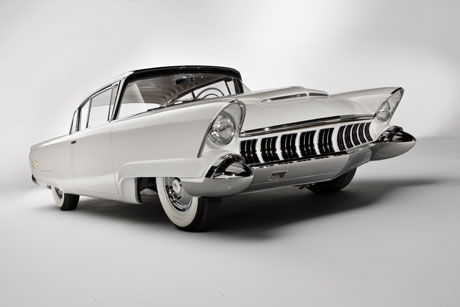SCM Analysis
Detailing
| Vehicle: | 1954 Mercury XM-800 |
| Years Produced: | 1954 |
| Number Produced: | 1 |
| Original List Price: | n/a |
| SCM Valuation: | $429,000 on this day |
| Tune Up Cost: | $150 |
| Distributor Caps: | $20 |
| Chassis Number Location: | Brass plate on frame behind front left corner of bumper |
| Engine Number Location: | Pad on upper front of engine near timing cover |
| Club Info: | International Mercury Owners Assn. PO Box 1245 Northbrook, IL 60065 |
| Website: | http://www.mercuryclub.com |
| Investment Grade: | A |
This car sold for $429,000, including buyer’s premium, at RM’s Automobiles of Arizona Auction in Phoenix, Arizona, on January 22, 2010.
Most post-war American concept cars were unbridled flights of fancy. From the impractical to the impossible, the Dream Cars of the 1950s had gas turbine engines, aircraft-inspired shapes, radar guidance systems, nuclear powerplants, and more. One of Ford’s 1954 concept cars, the FX Atmos, had tailfins that stood nearly four feet tall, a glass bubble top right out of the Jetsons, and twin sharp spears projecting from the front bumper. They were intended for some highway of the future to control the vehicle by radio, but in reality would have skewered pedestrians. The 1955 Lincoln Futura was so extreme it was used a decade later on TV as the Batmobile.
And then there are the stand-outs
But out of this era of exuberance, a few designs stand out. The 1953 Motorama Corvette went into production almost exactly as shown. A year later, Ford’s Thunderbird concept from the Detroit Auto Show was almost identical to the production version on sale that fall. The Lincoln-Mercury News Bureau called the Mercury XM-800, also introduced at the ’54 Detroit show, “the most advanced design in a car capable of going into volume production.”
The design by John Najjar and Elwood Engel was so strong it influenced Mercury and Lincoln automobiles for the rest of the decade. And ten years later, Engel replaced Virgil Exner as Chrysler’s design chief, partly due to his bold, clean design of the 1961 Lincoln Continental.
Though the XM-800 was not drivable, it was built on a production frame and had a development V8 engine. When the last owner, Tom Maruska, restored the vehicle, he had to create an electrical system to make the car operable. Fortunately, Najjar was able to assist with the blueprints. Maruska drove the XM-800 for the very first time under its own power last year, and it was shown at the 2009 Meadow Brook Concours.
The value question
Concept cars are traditionally hard to value. Some design and engineering cars from the GM Heritage Collection were snapped up last year for just $20,000. Yet the 1953 GM Futurliner Parade of Progress bus sold for $4.3m in 2006, while the 1954 Oldsmobile F-88 sports car concept sold in 2005 for $3.2m. The strange and extravagant Boano-built 1953 Lincoln Indianapolis Exclusive Study coupe sold for over $1m, as did the pretty 1952 Chrysler D’Elegance coupe.
So why would the XM-800 sell for a fraction of these prices? While the current market is strong enough for historic race cars of impeccable provenance, it seems it won’t support a six-figure dream car. There’s also an apparent GM bias, and comparable Ford and Chrysler models often sell for less. In this case, I believe the buyer got an important ’50s design study at an absolute bargain price, especially considering that the car was reported sold on eBay in January 2009-unrestored-for $315,500 (SCM# 119411).
I’m guessing the restorer is disappointed. Very well bought.
